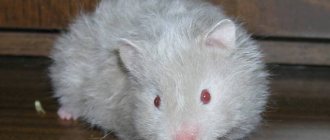Hamsters have always been popular to keep at home, especially when there are children in the house. They are easy to maintain and do not require special care. Among the advantages, we can note the low price, you need little space for keeping, and you don’t have to walk the hamster. Of the minuses it is low hamster lifespan, as well as the presence of an unpleasant odor from the cage when it is rarely cleaned.
On average, hamsters live only 2-3 years; rare individuals can live up to 5 years. A hamster that lives 4 years is considered a long-liver. As is often the case in the animal world, large individuals are able to live slightly longer than their small counterparts.
The lifespan of hamsters depends on several factors:
- species (breed);
- animal size;
- diet;
- conditions of detention;
- animal care;
- physical activity;
- genetics.
What shortens the life of hamsters:
- stress;
- diseases.
In nature, hamsters live somewhat shorter than at home, on average 1.5-2 years. Low life expectancy is associated with lack of food, attacks by predators, unfavorable weather conditions, and diseases. Hamsters often die while still young. It is the baby hamsters that are very vulnerable and are often attacked by predatory animals. Under favorable conditions, a large wild hamster can live up to 5 years.
Such a low life expectancy of hamsters is associated with a fast metabolism and susceptibility to disease and stress. The body of a small animal is not able to resist diseases and the animal often dies.
Life expectancy of different breeds of hamsters at home
Different breeds of hamsters differ greatly from each other. Some people have a strong tendency to certain diseases, while others can boast of good health. For example, hairy-footed hamsters at home live on average 2-3 years, maximum 4. For Siberian hamsters, the upper limit rises to 5 years, but such long-livers are rare.
Syrian
Ornamental Syrian hamsters can live a relatively long life if stress factors are excluded. The indicator reaches 5 years, the average age is 3-4 years. Syrian hamsters are unpretentious. They are easy to care for; your pet’s body is resistant to diseases and pathogens.
Syrian hamsters are easy to care for.
Dzungarian
Djungarian hamsters are more sensitive. Even a small change in the environment can cause them severe stress.
This shortens the pet's lifespan. On average, a Djungarian hamster lives 2-3 years if left undisturbed.
Dwarf
Dwarf hamsters live only 2 years. This breed, like the Dzungarian, is timid and experiences stress at the slightest influence. In order for your pet to live a long life, you need to pay special attention to its nutrition. The animal must receive a full set of nutrients. You cannot pamper your rodent with foods that are harmful to it.
Dwarf hamsters live no more than 2 years.
Siberian
Siberian hamsters are long-lived. Their average lifespan is 3-4 years. However, this breed has a high level of activity, so the animal must be provided with toys. It is advisable to place a couple with your pet. This will reduce your overall stress level.
Where to buy a hamster
Yes, the first thing that comes to mind is to buy it on the market. There are many of them and inexpensive. Cheaper than in a pet store or from official breeders. But there is a risk of buying a sick animal or not a hamster at all. At the pet store, you can ask for a certificate of examination by a veterinarian and make sure that the animal you like is healthy. If you buy from breeders, especially those who have been breeding hamsters professionally for many years, then most likely you can check their pedigree back to grandmothers, great-grandmothers and even further.
Another point that we must warn you about is that if you are going to give an animal to a small child, think about whether it will be easy for him to cope with the loss of a pet in 3-4 years.
Life cycle of hamsters
At home, hamsters live from 2 to 4 years, sometimes longer. Indicators depend on the conditions of detention. It is more difficult to identify general statistics for animals in the wild.
In the wild
In the wild, hamsters often die while still young. This may be due to the death of the mother, unfavorable environmental conditions, the invasion of a predator, natural disasters, etc. Dangers haunt animals throughout their lives. Hamsters are easily susceptible to overheating and hypothermia. It is believed that severe stress can cause a heart attack in an animal. The hamster may die due to hunger or eat poisoned food.
In the wild, hamsters are haunted by danger.
In the wild, rodents almost never die of old age. Older individuals become slow and weak. They often develop pathologies that interfere with leading an active lifestyle. As a result, old rodents become prey to predators or die from disease.
At home
The most favorable option for a hamster is life in captivity. The owners take care of their pets, carefully select their diet, use safe litter and toys, regularly clean the cage, etc.
In good conditions, the animal's lifespan reaches 4-5 years, but for this it is necessary to reduce the level of stress.
How many years do Djungarian hamsters live?
The Djungarian hamster is one of the common species that is recommended for home breeding. This animal is very active, sociable and inquisitive. It is simply impossible to get bored in his company, which is especially good for children.
In nature, dzhungarikas live from 1.5 to 2 years. These hamsters can live next to humans for three years. Of course, this is quite a bit when compared, for example, with cats, whose life expectancy reaches tens of years.
Photo: pixabay.com: UGC
But even with such a long life, a hamster’s life remains a source of positive emotions for its owner. Moreover, experienced furry owners note the following positive aspects of keeping them:
- Not always people have the opportunity to keep a pet for a long time. The hamster never manages to bore the owner, thanks to which the undertaken obligation to care for him is not difficult to fulfill;
- It is difficult for children to come to terms with the loss of a pet, but at the same time, this situation teaches them an understanding of life and death, as well as how important it is to enjoy every day and not waste time.
Photo: pixabay.com: UGC
Optimal age of a rodent to purchase
The best age for a hamster to move into a home is 3-4 weeks. Younger individuals most often die: rodents should not be separated from their mother too early. It is not recommended to purchase animals older than 3-4 weeks. At 1.5-2 months, females begin to reproduce, so if they are kept together in cramped conditions with males, there is a high probability of buying a pregnant individual. Even if you find future owners of the offspring, early birth will adversely affect the health of the animal and shorten its lifespan.
It is not recommended to purchase individuals older than 4 months, especially when the conditions under which they are kept are unknown. If you haven’t communicated with your pet, you won’t be able to train it. For the rest of its life, the hamster will experience stress when in contact with humans, which will negatively affect the animal’s lifespan. Another problem is the rapid development of diseases under poor living conditions. There is a high probability of acquiring an unhealthy individual.
How to find out the age of a hamster
In pet stores and markets, the age of a hamster is determined by weighing it. However, this method is inaccurate. Some individuals grow faster than others. Averages may vary depending on breed.
The age of a hamster is determined by its weight.
When purchasing, it is recommended to pay attention to the behavior of the animal. Young individuals are more active, they run and play, make sounds, and eat often, but little by little. Adult animals behave calmer. They are inactive, sleep more often, and eat rarely. In newborn rodents, the inside of the ear cavity is covered with white soft down. As you get older, the hairs thin out. In older individuals, there is no down inside the ears.
Young hamsters have eyes of the same color. They are slightly moist and shiny, and do not protrude much from the eye sockets. The appearance of cloudiness in the eyes indicates that the rodent is elderly.
When determining age, you can focus on the quality of your pet's coat. The thicker and tougher it is, the older the hamster. Young individuals have a rich, bright coat without bald patches. Newborn animals have soft fluff.
Coarse hair appears only at 2-2.5 weeks. The more pigment spots on the skin, the older the animal.
Life expectancy depending on the type of hamster
The hamster family includes 19 species (only 12 of them are found in Russia). On average, hamsters live 2-3 years, but depending on the species, this figure may decrease or increase.
| Species name | Description | Lifespan |
| Syrian | Fur color: golden, white, black, brown, silver. Length: up to 12 cm. Weight: up to 125 g. They feed on seeds, nuts, and can also feed on insects (ants, flies). The female's gestation period is about 16 days. The number of cubs in a litter is on average 8-10, in exceptional cases it can reach 20. Peaceful and sociable. | How many years do Syrian hamsters live? There is a whole article related to this. But in general, Syrian houses last from 2 to 4 years. In the wild, up to 3 years, but rather less due to the fact that hamsters are easy prey for winged predators |
| Brandt | Coat color: earthy brown on the upper body; ash gray on the lower part of the body; All animals of this type have a black spot on the chest between the front legs. With the arrival of winter, the color of the fur fades; in summer, the colors become brighter. Length: up to 19 cm. Weight: up to 300 g. Active at night. Brandt's hamster is a loner by nature and rarely gets along with other hamsters. | 2 years. |
| Newton's hamster | Fur color: grayish brown; a black stripe runs from the top of the head to the middle of the back. Length: up to 16 cm. Weight: up to 150 g. They stay awake late in the evening and at night. | Up to 3 years. |
| Radde | Fur: thick, somewhat harsh in the back area. Coat color: upper part dark brown; the lower one is black or gray. There are light yellow or gray spots on the cheeks. Length: up to 29 cm. Capable of bearing offspring up to 3 times a year. They are awake at night. | Up to 3 years. |
| Dzungarian | Fur color: gray with white splashes, brownish-gray, white with gray splashes, reddish-beige; there is a dark gray stripe on the back. Length: up to 11 cm. Weight: up to 66 g. In winter, this species sheds. The female's pregnancy lasts 26 days. There can be 7-9 cubs in a litter. | Up to 12 months in favorable wild conditions; Up to 24 months at home. |
| Campbell's hamster | Coat color: wild individuals have an ash-colored coat; domestic individuals can have any color (from white to black); a dark stripe runs from the neck to the base of the tail. Length: up to 11 cm. Weight: up to 30 g. The color of the coat does not change in winter. The period of wakefulness occurs in the evening and at night. During the year they can reproduce up to 4 times. | 2-3 years at home. |
| Roborovsky's hamster | It is considered the smallest representative of this subfamily. Fur color: sandy-golden; belly white; white spots above the eyes. Length: up to 6 cm. Weight: up to 31 g. Activity - at night. The female can bear offspring up to 4 times per season (from May to September). There can be 4-9 cubs in 1 litter. They get along well in a group, so it is better to keep hamsters of 2-4 individuals in an aquarium or terrarium. | 3 years. |
| Common hamster | It is considered the largest representative of this subfamily. Coat color: black-brown or completely black; 2 light spots on the sides. Length: up to 35 cm. Weight: up to 650 g. The period of wakefulness is at night and in the evening. | Up to 3.5 years in nature and at home. |
| Chinese | Fur color: brown, ash-gray, white, brown-black. Length: up to 12 cm. Weight: up to 45 g. They get along well both alone and in pairs or groups. | At home for about 3 years. |
| Short-tailed | Color: brown-gray, without spots or stripes. Length: up to 11 cm. Weight: up to 50 g. The lifestyle can be either diurnal or nocturnal. | Up to 3 years. |
| Barabinsky | Fur color: brown; There is a dark or black narrow strip along the ridge. Length: up to 14 cm. Weight: up to 45 g. Lifestyle: nocturnal, most active in the first half of the night. They can reproduce up to 5 times a year. The number of individuals in a litter is up to 11. This species of the hamster family does not take root well in captivity; sometimes the animal can bite its owner. | In nature – 2 years; At home – 3 years. |
| Tibetan | Color: dark gray with black spots. Length: up to 10 cm. Weight: up to 38 g. They can lead a lifestyle both nocturnal and diurnal. There are up to 6 cubs in one litter. | Up to 3 years at home. |
| Long-tailed | Fur color: dark gray with a red tint; the belly is light. Length: up to 14 cm. Weight: up to 48 g. They are awake at night. They breed from March to April, and one litter can have up to 7 young. | Up to 3 years. |
| Grey | Coat color: ash gray on top; the belly and tail are white. Length: up to 14 cm. Active in the second half of the evening. A female can give birth to offspring 2-4 times a year, 5-7 cubs. | 2-3.5 years at home. |
| Hamster Sokolov | Fur color: ash gray; There is a dark narrow strip along the ridge. Length: up to 12.5 cm. Weight: up to 40 g. | There is no exact information. |
| Mongolian | Coat color: light, almost white, without spots. Length: up to 16 cm. They are active mainly in the evening and at night. In winter they hibernate. | Up to 3.5 years at home. |
| Eversman's Hamster | Fur color: brown-black, reddish-brown, gray; belly white; there is a brown spot on the chest. Length: up to 17 cm. Weight: up to 43 g. They stay awake at night. A female can give birth 2-4 times a year; there are up to 6 cubs in a litter. | Up to 3 years. |
| Kansky | Coat color: light gray; The belly and chest are white. Length: up to 18 cm. Active at night. | 2 years. |
| Rat-like | Fur color: grayish brown; ashy belly; the tail is dark brown. Length: up to 26 cm. Weight: up to 245 g. They can lead both nocturnal and diurnal lifestyles. | There is no exact information. |
What to look for when buying a rodent
First of all, when purchasing a rodent, you need to inspect the living conditions. The cages must be clean. Cramped contents are not allowed. Sometimes sellers offer discounts on individual individuals. Most often, old, wounded or sick animals are given away at half price. You cannot agree to such a deal, because as a result you will either spend more money than you saved on treating your pet, or the hamster will die.
Behavior and activity
A healthy young animal behaves actively. It squeaks, constantly searches for food and plays. However, during the day the pet is less active, since hamsters are nocturnal. It is better to assess the behavior of rodents in the evening.
Healthy hamsters are constantly looking for food.
Eyes and coat condition
A healthy pet's eyes are clean, slightly moist, shiny, without discharge. There are no stains on the surface. The eyes should not protrude too far forward.
The fur of young hamsters is soft and not very thick. A hard, dense coat is present in older pets.
It is unacceptable to have bald spots or redness on the skin. The wool should not be wet.
Where is the best place to buy a hamster?
You can buy an animal from friends, at a pet store or at the market. All options have their advantages and disadvantages.
In the case of acquaintances, conditions of detention are often better. Professional breeders remove animals from each other in a timely manner, properly care for them, and provide them with high-quality food. Additionally, friends can give advice on content. The disadvantages include a small selection of animals.
A pet store is a mixed bag. The permissibility of purchasing a rodent in such an establishment depends on the conditions under which the animals are kept. If all the cages are clean, the pets have fresh water and food, and there are no sick animals, then the pet store is trustworthy. Otherwise, it is better to visit another establishment. Animals should not fight with each other. The presence of an unpleasant odor is unacceptable.
It is better to buy a hamster at a pet store.
The advantages of pet stores include a wide selection. Often establishments keep hamsters of not only different colors, but also breeds. If the pet store is good, it carries out veterinary control.
The disadvantage of this option is overcrowding of cells. Hamsters are kept in close quarters. Because of this, animals can get injured, get sick, become infected, become pregnant early, etc. In pet stores, rodents have almost no contact with people, so they will have to be tamed.
Spontaneous markets are not a desirable option. In most cases, sales are carried out by resellers who keep so many animals in one cage that they can barely fit. Since these are rodents from different places and from different parents, in such cramped conditions there is a high probability of infection of all individuals. Animals often fight due to stress and lack of territory.
The disadvantages of markets include the high probability of purchasing an unhealthy or old pet. The advantage is a wide selection of hamsters. The market sells pets of different breeds, colors and ages.
Resellers try to purchase recently born rodents, so the animal will be easier to tame.
How to extend the life of a hamster: basic rules
In order for your pet to live long and happily, he needs to create favorable conditions. But many owners do not make efforts to improve the quality of life of their pets, do not take them to the veterinarian in case of illness, and take the death of the hamster for granted. But it’s not difficult to extend their life.
The larger the animal, the more spacious the cage should be. So, for a Syrian hamster, a cage with an area of 50x30 cm and at least 25 cm in height is suitable. For dwarf hamsters, the cage may not be as large, with less space between the bars. A house and a wheel for a hamster means quality sleep and necessary physical activity, which has a good effect on the animal’s nervous system. The hamster will not experience stress and will live longer.
As for nutrition, today there is a large selection of balanced food for hamsters of different breeds on sale. Any pet store will select the right food for you based on the size and age of your pet. In addition, fresh water should always be freely available in the cage.
What factors shorten the lifespan of hamsters?
The following factors are unfavorable for rodents:
- stress;
- cramped living conditions;
- frequent bathing;
- excessive attention;
- poor quality food and water;
- rare feedings, etc.
Hamsters should not be bathed frequently.
Any unfavorable factors shorten the life of the pet. They can provoke the development of pathologies and lead to the early death of the hamster. For example, drinking stale water can lead to infection or poisoning.
Frequent bathing
Hamsters are not among the animals that take water calmly. For small pets, liquid is a potential source of danger. For this reason, the hamster perceives every bath as a threat to life, an attempt to drown it. This causes severe stress and shortens life expectancy. In rare cases, discomfort from the process can cause death.
It is not advisable to bathe hamsters in water. The pet gets rid of dirt on its own. As a last resort, some breeds may benefit from sand baths. If the dirt is extensive, you can clean the wool with a special brush. Bathing is carried out only when there is no choice.
Stress
Under the influence of stress, a hamster's internal organs wear out faster. In some cases, this condition leads to death. After a strong shock, the pet may become lethargic, refuse food and water, begin to hide and become exhausted.
Stressing a hamster can lead to its death.
Stress occurs for various reasons. For example, single people do not like it when neighbors move in with them. Hamsters, who prefer large groups, on the contrary, yearn without individuals of their own species. Even a child can cause stress to a pet if he constantly tries to play with the rodent. Too bright light, loud sounds, etc. can cause discomfort.
Presence of diseases
Hamsters sometimes develop chronic pathologies. Additionally, rodents are susceptible to infectious diseases. An animal can become infected, for example, with tuberculosis, plague or tularemia. Signs of infection include trembling, aggressive behavior, increased breathing, discharge from the eyes or nose, loss of fur, etc.
Improper care
Improper care can cause a significant reduction in the life of a pet and its death. For example, animals fall out of hands and are injured if handled carelessly.
Positive factors and opportunities
By getting a hamster and teaching your child how to properly care for it, you are instilling in your children the ability to care, be responsible, and compassionate. The death of a hamster will show the child that nothing lasts forever and will teach him to appreciate what we have.
For people who are not accustomed to responsibility, the appearance of a hamster in the house will be a test of “strength”. You can check yourself to see if you are responsible enough, for example, to get a dog.
Keeping an animal does not require a lot of money or time resources; they do not need to be walked or undergo any other regular procedures (besides natural ones).
How to increase your pet's lifespan
To prevent the early death of your pet, you need to provide it with high-quality nutrition. It is necessary to provide the animal with the opportunity to lead an active lifestyle. To reduce the risk of infection, you need to remove the cage in a timely manner. If you want to give your pet walks, they must be safe for his life.
Proper nutrition
Most types of food common to humans are contraindicated for a hamster. Pets are offered grains and legumes. The menu includes nuts, peanuts, dried fruits and berries. Crickets in small quantities are suitable as a source of protein. Vegetables include pumpkin, cucumbers, zucchini and carrots. Rodents are offered plantain leaves, dandelion leaves, and carrot tops as treats. Hamsters happily eat hay and greens.
You can give your hamster a variety of nuts.
Large cage and timely cleaning
The minimum cage size for 1 individual is 30x30x45 cm. Too small will cause stress in the animal. Overpopulation is also a danger. Even in a spacious cage, animals should not be kept in large groups. This may not suit their natural habits.
The cage should have space for a toilet, toys, food and water bowls. You cannot use an aquarium as a home. If there is insufficient ventilation, your pet will have breathing problems. Cages with a plastic monolithic bottom and metal rods are better suited for keeping pets.
Cleaning is carried out 2 times a week. At this time, the pet is placed in a spare cage so that it does not escape. No chemicals are used for cleaning. As a last resort, in case of severe contamination, use baby soap or shampoo for hamsters.
Games and activities
Pets experience stress when they do not have the opportunity to expend excess energy. To prevent deterioration in health, it is recommended to place a wheel in the cage. You can purchase a special transparent ball: it will allow your pet to safely walk around the house.
What does proper care of a hamster mean?
What can we do to increase the lifespan of a hamster in our home?
- Healthy eating. Somehow it turned out to be formulaic. Now everyone is obsessed with healthy eating, both hamsters and their owners. Use special food mixtures for rodents for feeding, or feed them yourself with boiled cereals, protein foods, herbs and vitamins. But before you give anything to the animal, find out what foods you should not feed your pet.
- Choosing the right cage and house (read this article). Choose a cage that is not cramped and does not contain toxic substances, because the hamster will definitely chew it. It is better to choose a simple, but spacious single-tier cage with frequent bars, rather than a beautiful two-tier, but cramped one, I don’t know what it’s made of.
- Hamster furniture. This is not exactly furniture in the usual sense. I called her that only because she is in your pet’s apartment (cage). It would be more correct to name sports equipment: ladders, swings, wheels or plates and other attributes of a healthy, active life. Wild relatives run several kilometers per day. Tell me, do you run regularly or only when you are late? If your animal does not show activity for a couple of days, especially at night, take it to the vet. This is an unhealthy sign.
- Hamster hygiene. Don't get involved in this at all. Not all women take such good care of themselves as hamsters. All you need to know is that you don't have to bathe your hamster in water. Yes, they swim well, but he is subject to extreme stress and most likely he will also catch a cold. The result is a shortened lifespan of the hamster.
- Cleaning the cage. Yes, this is also a reason for stress, but alas, there is no escape from it. Otherwise, the smell in the apartment will not be great. Fill the drinking bowl with fresh water every day and throw away any leftover food. The cage itself can be cleaned every one and a half to two weeks.
- Stress. Hamsters are desperate alarmists. Any change in the environment can cause stress. Even if you just sneeze next to him, a couple of gray hairs will appear. Any nervous overstrain will immediately affect the health of the rodent, and if there are many such shocks, then its lifespan will be significantly reduced. If there are other animals in the house besides the hamster, such as a cat or a dog, then this will not bring positive emotions to the animal. For a cat, he is generally a legitimate prey, whose lifespan may end as soon as you turn your back.
Interesting fact : the record for hamster life expectancy was recorded in England. The animal lived for 19 years. And in Germany there lived a hamster named Robo. During his life, he experienced a lot: he was in the teeth of a cat, was operated on twice, his leg was cast, his paw was amputated... But the hamster lived for 4 years.
Useful tips
Pets like hamsters need good care, so you need to follow some helpful tips from zoologists.
Cell
For a hamster you need to prepare a cage that is of medium size. The cage should not be high. You can put a wooden house inside your pet's home. But the cage itself does not need to be made of wood, because the hamster can chew its home.
A good solution would be to purchase a metal cage, but it is not recommended to buy a housing made of copper. You can also take an unnecessary aquarium instead of a cage. Some owners also use a regular box, and to make the hamster feel comfortable, you can put scraps of fabric, soft paper or cardboard inside the box. This way, the pet can make its own nest.
The standard sizes of a pet house are:
- height – 13 centimeters;
- width and length - 16 centimeters each.
You cannot place your pet in a three-liter glass jar, as the animal will feel cramped and stuffy. You need to install a wheel inside the house; the hamster needs it.
With the help of the wheel, the animal maintains its physical shape. If there is no daily jogging, the pet will be sleepy.
Toilet
The most difficult part of keeping an animal is the toilet. To avoid smell, the bottom of the house should be retractable. You need to put organic glass or plastic on the bottom. Using a pull-out tray, you can quickly clean up debris and eliminate odors. You need to sprinkle sawdust from non-resinous wood on the pallet.
Cleaning
Once a week you need to clean your hamster's house. Every 30 days you need to disinfect your home with a 0.2 percent bleach solution. The cage should be cleaned without disturbing the pet and its supplies. If you throw away supplies, the animal will experience stress. The only exceptions are perishable products.
A hamster is an absolutely safe pet and can be bought for a child. It is not difficult to care for and maintain an animal at home. The main thing is to provide timely care and provide a nutritious diet.
For information on how long hamsters live, see the following video.
This is interesting: What do tadpoles eat?
About long-lived hamsters
It is alleged that among the Syrian breed of hamsters, specimens have been recorded that have reached the age of seven. These are somewhat unique, because only one in a million survives to age five. Typically, long-lived animals are those that have lived for 3.5 years. And we have the power to help our pets reach this respectable age.
A hamster is a beautiful animal in every sense, capable of not only touching with its stuffed cheeks and fluffy little body, but also relieving stress, charging with a positive mood and being a true friend for children. When choosing a hamster, remember that you are responsible for the one you tamed. Surround your pet with attention, care and love, and he will definitely answer you in kind.
Was this article helpful?
Yes
No
Which hamsters live longer?
Of the main and common breeds, Syrians have the longest lifespan. They naturally have better immunity than others and better health. The average lifespan of a Syrian hamster is 3-3.5 years.
Dzhungariki is a more gentle breed. They react more strongly to any changes in their lives. Even regular cage cleaning is a lot of stress for them. And if you also tore through his pantry with food supplies, then at least hang yourself right away. On average, the life expectancy of a Djungarian hamster is 2.5 years.
The lifespan of dwarf hamsters is no more than two years, provided they have good and proper nutrition.
The average lifespan of a Siberian hamster is 3 years. All Siberians (cats, dogs or hamsters - it doesn’t matter) are initially famous for their good health.
Campbell hamsters live on average 2-3 years.
Not the most popular, or rather rare, Roborovsky hamsters live for about 3 years.
These are the approximate lifespans of different species of hamsters. You should not focus on them, since this is the lifespan at home - there is always food and water and no enemies. If the owner of the animal is a small child who likes to play with his pet, then it probably won’t be stress-free. Even if the child himself did not want to irritate the animal. In the wild, with irregular nutrition and an abundance of enemies, the lifespan of a hamster is even shorter.
Why do hamsters live so short? Fast metabolism, small, disease-resistant organism, sensitivity to temperature fluctuations. It is a law of nature that small creatures in most cases live shorter lives than large ones.
What increases life expectancy
You should decide in advance on the place where the hamster’s cage (aquarium, terrarium) will be located. Such a place should be away from drafts and direct sunlight. The best solution is on a table or bedside table away from the window.
Food
The hamster is not an omnivore; most types of food are contraindicated for it. To increase your pet's life expectancy, you need to feed it only the following foods:
- cereals;
- millet;
- corn;
- beans;
- peas;
- nuts;
- peanut;
- dried berries and fruits;
- whole wheat bread;
- greenery;
- dandelion leaves, plantain;
- carrot and beet tops;
- sprouted grain;
- hay;
- vegetables (carrots, zucchini, cucumber, pumpkin);
- among insects - crickets;
- vitamins and minerals in tablets or drops.
The following foods can be added to your hamster's diet in small quantities:
- cottage cheese;
- eggs;
- cooked meat;
- small insects.
The following products are strictly contraindicated for use by hamsters:
- mushrooms;
- fatty foods;
- flour products;
- exotic fruits (citrus fruits, pineapples);
- onion;
- garlic;
- sweet products;
- cabbage.
The food bowl should not be left empty, otherwise the animal will start stockpiling.
Cell
The minimum cage dimensions for 1 individual should be 30 cm wide, 30 cm long and 45 cm high. A smaller cage will depress the animal; As a result, the rodent will begin to experience stress. In the cage, it is necessary to determine places for a bowl of food and water, a toilet and a wheel (if available).
The hamster's house should have good ventilation. Otherwise, the animal will experience breathing problems.
It is better to purchase a cage with metal bars and a plastic monolithic bottom. The metal structure is much easier to clean. The plastic bottom will help keep your hamster's claws safe.
Entertainment
To increase physical activity for the animal, you should additionally install a hollow wheel in the cage, inside which the rodent can run.
To allow the animal to roam freely around the apartment, you can buy a special transparent ball, inside of which there is a place for the hamster. The animal will be able to move around the apartment and explore the world around it, and the owner will not worry about the animal getting lost.
A container of sand placed in the cage will help keep the animal occupied for a long time. If you bury a piece of dried fruit or nut there, the animal will be keen on searching for a treat.
Positive emotions have a beneficial effect on the mental state of the rodent.
Cleaning
The cage must be cleaned 2 times a week. When purchasing a main cage, you should purchase an additional smaller one. In this case, the hamster can be transplanted into an additional cage for the duration of cleaning and not be afraid that the rodent will escape.
You should not use strong chemicals for cleaning, as many components can cause allergies in your pet. If the cage tray is very dirty, you can wash it with baby soap or hamster shampoo. Rinse all items inside the cage under running water and dry completely. Wipe the rods with a damp cloth.
Fresh air
Just like for the human body, clean fresh air is beneficial for the hamster's body. You can only walk an adult animal; he must be at least 8 weeks old. It is advisable to let the animal walk on the grass on a flat surface. At this moment, the owner should monitor the pet very carefully, otherwise he will disappear from sight and get lost. For large breeds of hamsters, you can purchase a special leash.
You should not let your animal try grass and plants, as some species may be poisonous to the animal.
Irina Ivanishchena
I am engaged in professional breeding of hamsters and rats on an ongoing basis. I know something about them that most people don’t know. Always open to constructive discussion
Post Views: 4,442
Hamster lifespan
Alas, our animals are not long-lived. At home, hamsters usually live 2–3 years. Depending on the breed of hamster, life expectancy may be longer. It is not for nothing that we mentioned the Roborovsky breed. Among its representatives there are animals aged 4 years. Taking into account the fact that even by hamster standards the Roborovsky breed is the smallest, 4 years is a respectable age for a rodent.
Our life is sometimes dangerous and difficult, and at first glance, it seems invisible.
How long do representatives of common breeds live - Syrians and Dzungarians? And at the same time, we’ll think about how to extend their lifespan. In principle, there is nothing complicated about this. The main thing is to know how to properly maintain your furry, what you can and even need to give him, and what to refrain from. Before you can take care of your pet, you must first buy it. If you want your hamster to live longer, then you should pay attention to certain points at the purchase stage:
- Ask the seller about the age of the animal. A change in his usual environment will be very stressful for a hamster, so it is better if he endures it at a young age. Severe stress will negatively affect nutrition, and subsequently the health and life expectancy of the hamster. You shouldn't take very small ones, they are still weak. There is a risk of not being able to feed. Choose hamsters between 3 weeks and 5 months of age.
- Pay attention to what your future pet looks like. This is necessary so as not to buy a sick animal. Feel free to take a look around. A normal, healthy hamster has smooth fur, no bald spots, a dry tail, shiny eyes and not watery. The hamster itself is active (unless, of course, you just woke it up), reacts quickly to touch - these are the signs of a healthy animal that will definitely live its 2-3 years.
Djungarian old age
A sad fact: even if it is possible to make the animal long-lived, the lifespan of Djungarian hamsters is short. Preparing for the death of a beloved pet is difficult, but it is better to do it in advance.
It is especially difficult to explain what is happening to children, but if you begin to prepare in advance, the loss will pass easier. For example, tell your child that the hamster goes to a better place when it leaves us. Some parents, not wanting complex explanations, simply buy the same Djungarian hamster. But if the child notices, you will have a hard time.
If your pet has been living for more than 3 years, and you notice that activity decreases and appetite decreases, go to the veterinarian. If your concerns are confirmed, consider the possibility of euthanasia: there is no need to torture either yourself or the animal.
At what age is it better to buy
This is a very important question. How much joy and positivity the rodent will bring you depends on how correct the answer you find to it depends.
Experts advise buying an animal at least 1 month old. Younger individuals are highly dependent on mother's milk and just hamster society - they are not very comfortable living alone.
At the same time, it is not advisable to take hamsters older than 1 year. These are already older individuals - they move little and sleep more. Of course, for a child, watching the house in which his pet sleeps will not bring too much joy.
As for the rest, you must decide for yourself. But most breeders try to buy young rodents - they are cheerful, active and playful. Plus, thanks to their youth, they will spend more time with you. But for fast-living hamsters, every month is a whole era.











